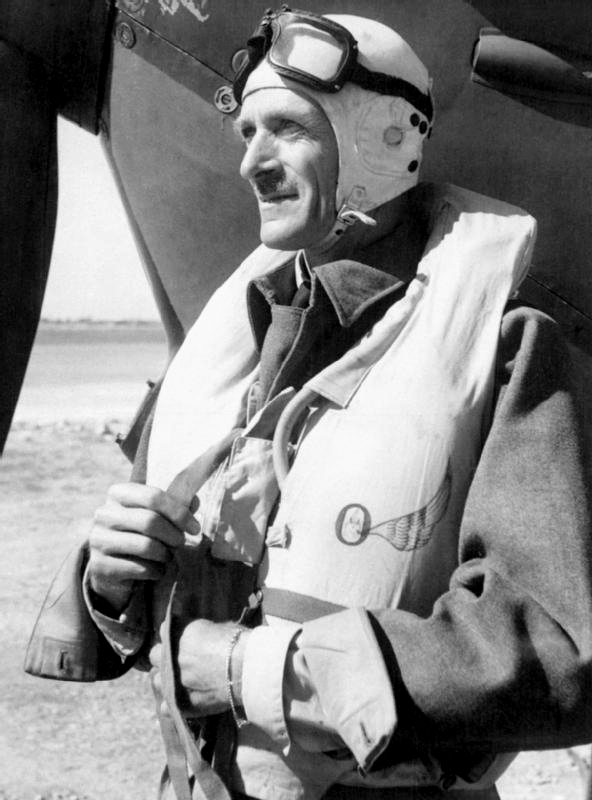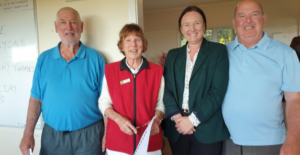Flying in the face of Air Ministry tactical thinking, Sir Keith Park led his 11th Fighter Group to a crushing defeat of the Luftwaffe that clinched the Battle of Britain during World War Two.
He ignored an official directive to use massive concentrations of fighter aircraft, sending instead small groups of Spitfires and Hurricanes into the air over London and the South of England to face the Germans. His tactics paid off on September 15, 1940 with an overwhelming victory in which at least 185 German aircraft were shot down. This triumph – the first and critical one of World War II – sealed the fate of the Luftwaffe and was largely responsible for the eventual Allied success.
Keith Park, who became known as the “Defender of London”, had earlier refused to obey an Air Ministry order to set explosive charges at British air bases because of the effect it would have on the morale of his men.
This was in keeping with the character of the man who was born in Thames in 1892, the third son and ninth of ten children born to Frances Rogers and Scotsman James Park, who earned an international reputation as a geologist.
Keith, educated at King’s College, Auckland, and Otago Boys’ High School, Dunedin, enlisted in World War I at the age of 22. He served as a gunner with the Third Reinforcements from New Zealand.
Commissioned during the Gallipoli campaign, he transferred later in the war to the Royal Flying Corps.
His World War I service earned him a Military Cross and bar “For conspicuous gallantry and devotion to duty in accounting for nine enemy aircraft, three of which were completely destroyed and six driven down out of control.”
He was also awarded a Distinguished Flying Cross and a Croix de Guerre, a French military decoration recognising feats of bravery.
His fearlessness and iron will came to the fore again in World War II when, a few weeks before the Battle of Britain, he flew the last fighter over Dunkirk, the scene of the evacuation and rescue of hundreds of soldiers.
Later in the war he commanded the defence of Malta, which could only be protected from the air, earning him further fame. Due to lack of fuel on the island, he did his rounds on a bicycle where he learnt more from his airmen and the weary civilians than from processions of dignitaries. At the end of World War II, Park was Commander-in-Chief of the Allied Air Forces in South-East Asia. He regarded pompous British officers with distaste and expressed his admiration for American energy and methods. He gained a reputation as an astute tactician and a popular hands-on commander but he also became victim to envy from the Royal Air Force command.
“Jealousy and cliques,” Winston Churchill would later say, precipitated derision and demotion.
Side-lined to Air Training, Park continued to fight against pointless paperwork and patronising attitudes to lower ranks. After the war he worked in civil aviation in South America and England. He retired from the Royal Air Force in 1946 in the rank of Air Chief Marshal and returned to Auckland where he took up a number of civic roles.
Despite his phenomenal achievements, Sir Keith Park received little public recognition.
On a visit to Thames in 1946, Sir Keith and Lady Park were met by local dignitaries and taken on a tour of the town, visiting Park’s previous homes in Moanataiari, Sandes St and Totara. After a luncheon at the Hotel Imperial, he addressed a large gathering of school children in the High school grounds.
“It is a great honour to come back and receive a welcome like this from Thames,” he said.
Mayor Ensor said when people had read of his career through the years, they had little realised that he was one of Thames’ sons.
Park, tall and erect, with alert blue eyes sparkling with a quick sense of humour, made an immediate impression with his strong personality, keen perception, courtesy and enthusiasm. Even in old age he looked deceptively young, walking briskly and carrying himself well.
Air Chief Marshal Sir Keith Rodney Park died in 1975 aged 82. Between the wars he had served in the Royal Flying Corps in Egypt and Buenos Aires. It was while an air attache in Buenos Aires that he met his wife, Dorothy. They had two sons. One, Colin, was killed while serving with the Malayan Constabulary in 1951.
One of the highlights of Sir Keith’s career was when he was aide de camp to King George at his Coronation in 1937. Sir Keith Park was one of the best-loved RAF commanders of World War II. He was as skilled at offence as he was at defence and his record made him the most outstanding fighter commander in the history of air warfare. He was, as the Auckland Star stated on his seventieth birthday in 1962, “one of the ten greatest New Zealanders.”
DETAILS: The Battle of Britain Commemorations this year are on September 11 at 11am at the Thames Airfield, in the proximity of the replica Hurricane Fighter which is stage one of the Sir Keith Park Memorial. The main feature of stage two is a 2.3m bronze statue of Sir Keith Park in his flying uniform, which will be mounted on plinth under the existing replica Hurricane Fighter at the Thames Airfield. To complete stage two, the Sir Keith Park memorial organisation is looking to raise $335,000. More info: www.sirkeithparkmemorial.org.nz.




